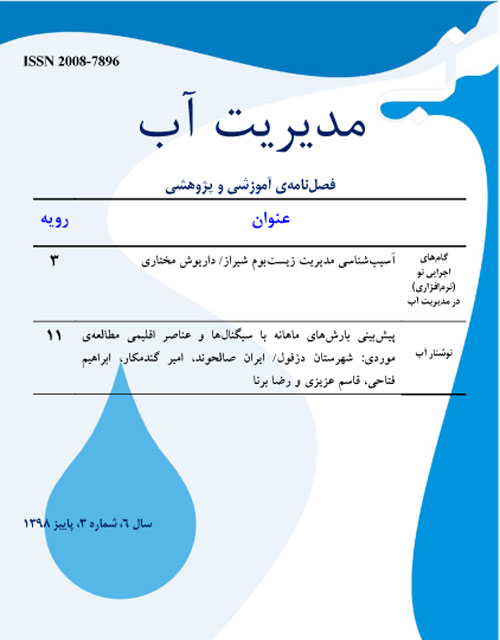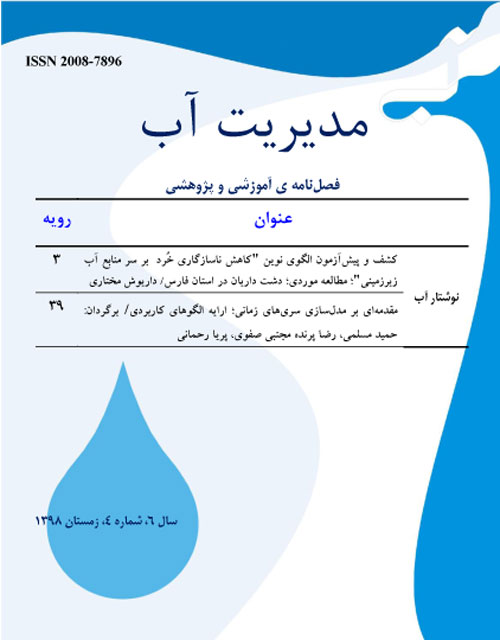فهرست مطالب

نشریه مدیریت آب
سال ششم شماره 3 (پیاپی 18، پاییز 1398)
- تاریخ انتشار: 1398/09/25
- تعداد عناوین: 2
-
صفحه 3
در این یادداشت کوتاه، آسیب شناسی کوتاهی از عملکرد مدیریت شهری شیراز بر پایداری زیست بوم شیراز به عمل آمده است. از این نوشته میتوان این درس را آموخت که در یک پهنه آبخیز لازم است یکپارچه عمل کرد و هر گونه اقدام اجرایی در حوزه مدیریت شهری، مستقیما بر پایداری آبخیز تاثیر میگذارد.
کلیدواژگان: کلانشهر شیراز، زیست بوم، مدیریت شهری -
صفحه 11
در این پژوهش به منظور مدل سازی بارش دزفول از دادههای بارش ماهانه ی ایستگاه همدید دزفول در بازه ی آماری (2014-1961) به مدت 53 سال به عنوان متغیر وابسته و شاخصها و عناصر اقلیمی به عنوان متغیر مستقل استفاده شده است. برای استفاده از مهم ترین عناصر اقلیمی موثر بر منطقه ی مورد مطالعه از تحلیل عاملی استفاده شد و برای تشخیص مهم ترین سیگنالهای اقلیمی موثر بر متغیر وابسته از انواع روش های تحلیل رگرسیون استفاده شد. به دلیل رفتار غیرخطی بارش از شبکههای عصبی مصنوعی جهت مدل سازی بهره گرفته شد. برای ورود به شبکه ی عصبی، داده های بارش مورد تحلیل رگرسیونی قرار گرفت. نتایج پژوهش آشکار ساخت که پیش بینی سیگنالهای اقلیمی، دارای ضریب همبستگی بالاتری بود. برای نمونه، ضریب همبستگی با روش حذف تدریجی داده ها 100 درصد و روش گام به گام 88/99 درصد بود. از بین 144 واحد (سیگنال اقلیمی در هر ماه) 16 واحد یا شاخص در ماههای تعیینشده با 18 شبکه جهت پیشآگاهی بارش با ضریب همبستگی 88/99 درصد جهت پیش بینی انتخاب شد. برای پیش بینی بارش با عناصر اقلیمی از بین 7 مولفه اثرگذار، مولفه ی دوم بارشی-دمایی در رگرسیون به احتمال 100 درصد و در سیستم عصبی به احتمال 7/99 درصد موفق بود.
کلیدواژگان: تحلیل عاملی، دزفول، رگرسیون، شاخصهای اقلیمی، شبکه عصبی پرسپترون، شیب خط
-
Page 3
In this short note, a brief pathology of the performance of Shiraz urban management on the sustainability of Shiraz ecology has been done. From this article, we can learn that in a watershed area, it is necessary to act in an integrated manner, and any executive action in the field of urban management directly affects the sustainability of the watershed.
Keywords: Shiraz metropolis, ecology, urban management -
Page 11
In this study, in order to Dezful precipitation modeling were Used from the monthly precipitation data of Dezful Joint Station in the statistical period (2014-1961) for 53 years as a dependent variable and climatic indicators and climatic elements as independent variable. Factor analysis was used to apply the most important climatic elements affecting the study area, and varieties of regression analysis methods were used to identify the most important climatic signals affecting the dependent variable.
Due to the nonlinear behavior of precipitation, artificial neural networks were used for modeling. To enter the neural network, precipitation data were applied to regression analysis. The results of the study revealed that the prediction of climatic signals had a higher correlation coefficient. For example, the correlation coefficient with the gradual data removal method was 100% and the step-by-step method was 99.88%. Between of 144 units (climatic signal per month), 16 units or indicators were selected in 18 months with 18 networks for precipitation with a correlation coefficient of 99.88% for forecasting. To predict precipitation with climatic elements, among the 7 effective components, the second component of precipitation-temperature was 100% probably successful in regression and 99.7% probably in nervous system.Keywords: Factor Analysis, Dezful, Regression, Climatic Indicators, Perspetron Neural Network, Line Slope


